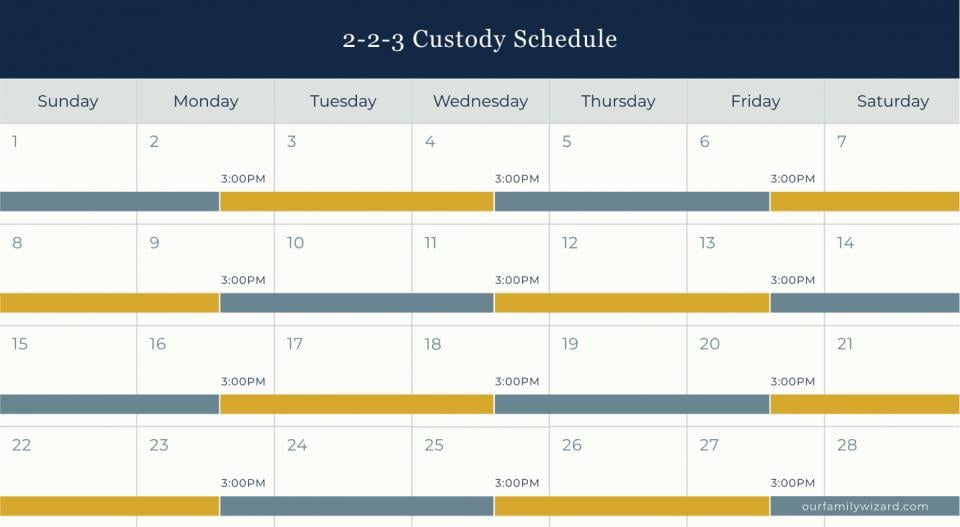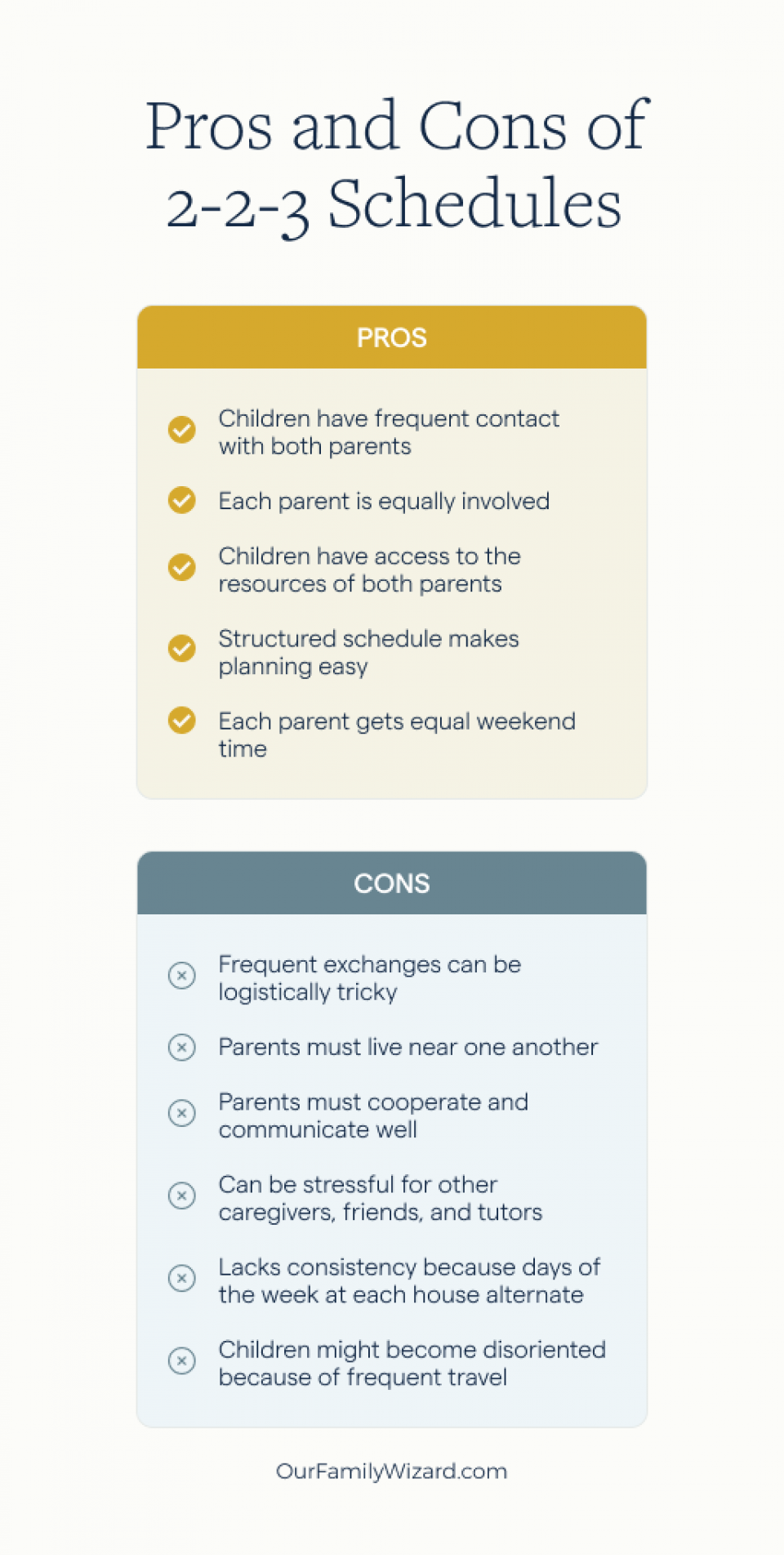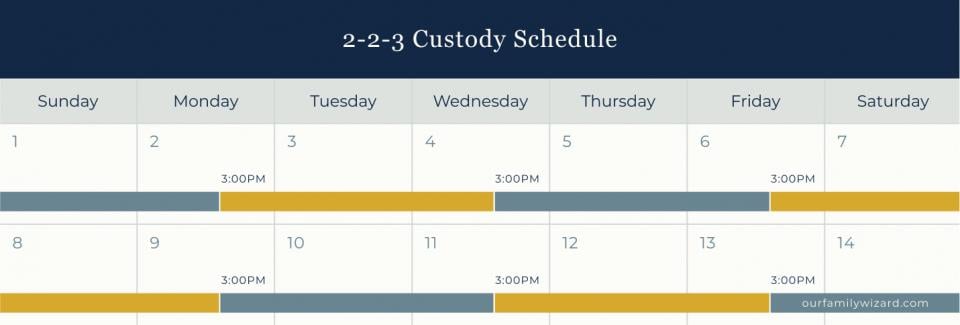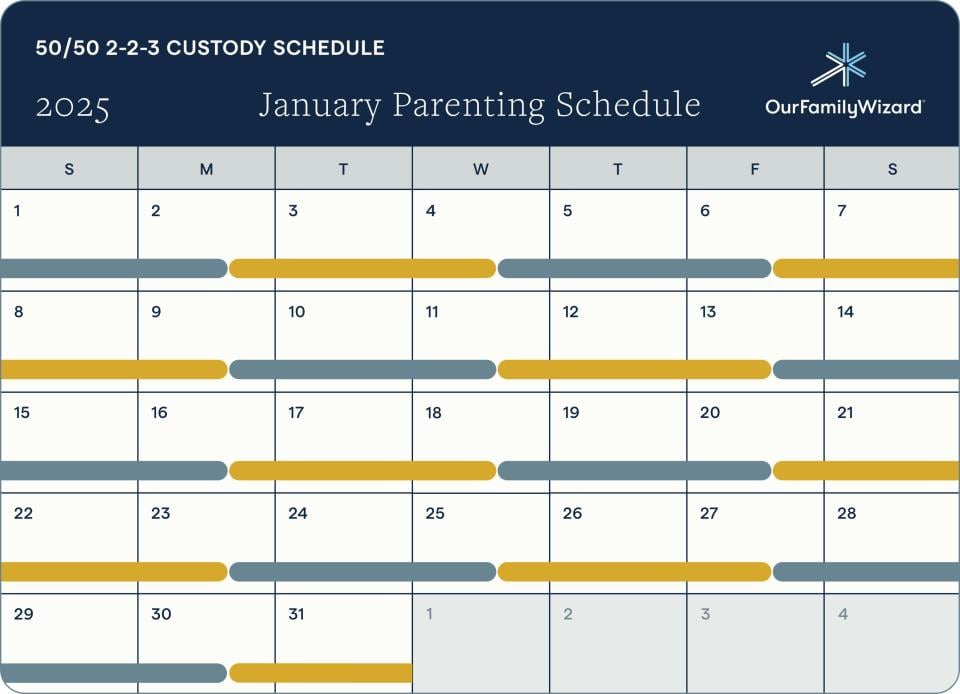2-2-3 Custody Schedules: Samples, Templates & Tips
Co-parenting works differently for different families. It’s important to select a parenting schedule that aligns with your children’s needs to ease the transition for them and for you. Read more to see if the popular 2-2-3 custody schedule will work for your family.
What Is a 2-2-3 Custody Schedule?
A 2-2-3 custody schedule is a co-parenting schedule where each parent has equal time with their child. Parents split alternating sets of days over a two week period. The 2-2-3 schedule offers kids frequent time with both parents but could present logistical challenges.
Key Takeaways
- The 2-2-3 schedule is a 50/50 schedule that gives you and your co-parent equal time with your children.
- The 2-2-3 schedule requires frequent exchanges and won’t work well if you live far from your co-parent.
- Some kids thrive under a 2-2-3 schedule because they can see both parents regularly.
- Other kids find the constant travel disorienting and stressful.
- Parents use automated co-parenting calendars to best manage the 2-2-3 schedule.
2-2-3 is a common schedule rotation used by parents with joint physical custody, an agreement in which a child spends a lot of time with each parent. The 2-2-3 schedule, however, is an option that works specifically for co-parents who share time with their children on an equal, 50/50 basis.
You’ll often see the 2-2-3 schedule rotation referred to as a “custody schedule” or a “parenting schedule.”
50/50 parenting time rotations, like 2-2-3, work for some families and not for others. But a 2019 review published in the Journal of Family Sciences found that 50/50 arrangements could lead to positive outcomes for children. Still, they advised that blanket recommendations are inappropriate because every family’s situation differs.
Before selecting a routine, you should consider your children’s schedule, your relationship with your co-parent, and your child’s age. The 2-2-3 schedule can be logistically complicated, but a digital co-parenting calendar can automatically schedule the rotation to help keep you on track.
Michelle Dempsey-Multack, Certified Divorce and Co-Parenting Specialist, summarizes the sche dule nicely: “Although a 2-2-3 schedule doesn’t make sense for all families, it is a great option for co-parents whose work schedules allow for it, who have the ability to share in the parenting responsibilities equally, and who live near the other parent.”
dule nicely: “Although a 2-2-3 schedule doesn’t make sense for all families, it is a great option for co-parents whose work schedules allow for it, who have the ability to share in the parenting responsibilities equally, and who live near the other parent.”
“This schedule is especially helpful for children under the age of 4, who are adjusting to co-parenting and may have a harder time separating from one or both parents,” says Dempsey-Multack.
How Does a 2-2-3 Custody Schedule Work?
In the 2-2-3 custody schedule, the first parent cares for the kids for two days, and then the kids go to the other parent for the next two days. Then, the kids go back to the first parent for three days. The numbers in the schedule refer to the number of overnights the kids spend with each parent.
It's important to know that the 2-2-3 schedule does not keep the days of the week consistent between each parent. This may be confusing for some children during the week, but also know that this schedule does allow co-parents to rotate the weekends.
For example, if the kids start the school week with you on Monday and through Wednesday morning (two overnights), your co-parent will have them on Wednesday afternoon through Friday morning (two overnights), and they will come back to you for a long weekend on Friday, Saturday, and Sunday into Monday morning (three overnights).
Then, the schedule rotates: they will start the next school week with your co-parent on Monday and Tuesday. This means that your co-parent will have them over the next weekend, too.

Who Is a 2-2-3 Custody Schedule Good For?
A 2-2-3 parenting schedule works well for parents who have flexible schedules and live near one another. Also, younger children who feel securely attached to both parents may prefer being able to see each parent regularly.
Families that fit these categories might thrive with the 2-2-3 schedule:
- Parents who live near one another: The 2-2-3 schedule involves frequent transitions and exchanges. It’s not only the children who move between homes—their belongings move between homes, too. This is important to consider if you and your co-parent live several miles apart.
For example, schoolwork commonly slips between the cracks when a child travels from home to home. If your child accidentally leaves their spelling homework at your co-parent's but they are with you, you may need to arrange a quick meet-up with your co-parent.
If that arrangement doesn’t go smoothly, perhaps your co-parent isn’t home, or it’s too late to stop by, your child may fall behind in their schoolwork or otherwise feel frustrated and stressed.
- Parents who communicate successfully: Effective communication between co-parents helps make the 2-2-3 schedule work. If you and your co-parent face constant conflict or struggle to communicate effectively, you won’t enjoy the constant interaction with your co-parent that the 2-2-3 schedule demands.
- Neither parent wants to be flexible with their time: Interestingly, the 2-2-3 schedule can work well when one or both parents are actually inflexible with their time. The more frequent exchanges make it so that neither parent has to go too long without seeing the child. Plus, this schedule can be helpful if exchange days are challenging due to rigid work schedules.

As family law attorney Alexandra “Lexie” Rigden notes, the 2-2-3 schedule aligns well with the school week and, if planned correctly, can help parents avoid conflict within tense relationships.
“Exchanges only happen on weekdays: Monday mornings, Wednesday mornings, and Friday mornings. Co-parents with a stressful relationship can design the 2-2-3 to minimize interactions if their child is old enough to go to school. For example, a child can take the bus to school from Mom’s on an exchange day, to later be picked up by Dad at school. If the logistics work out, you don’t need to exchange at each co-parent’s house.” - Parents with flexible or predictable schedules: Flexibility and predictability in parents’ work and personal schedules will also support the frequent transitions in a 2-2-3 schedule. It can be harder to make this kind of rotation work if you and your co-parent don’t have a steady structure to your day-to-day routines.
If you work a job with an unpredictable schedule, like as an on-call firefighter or nurse, it may be hard for the 2-2-3 routine to work consistently. It can also be tough if you work inflexible hours.
Say you start your workday at 7 a.m. without exception, it may be challenging to make time for exchanges. Or, if you work 60 hours a week but your co-parent works 30 hours a week, trying to split time evenly may not be realistic.
Unpredictable or inflexible work schedules may start this parenting time arrangement off on a shaky, vulnerable foundation that will cause stress for everyone when changes inevitably occur.
- Children who are securely attached to both parents: Attachment theory describes the four principal ways children become attached to their parents. Children that exhibit secure attachment have positive, emotional relationships with their parents.
Securely attached children go to a parent when they want to feel comforted. If a child is securely attached to both parents, having a 2-2-3 schedule will ensure they are not away from either parent for too long, strengthening their bond with you and their other parent.
Also, for younger children still forming an attachment style, this schedule provides well-balanced time with both parents, giving the child plenty of one-on-one time to develop solid and secure attachments with each. It is essential to consider that any custody schedule could influence your child’s attachment style, which can have implications on how they manage future relationships as adults.
- Young children: Younger children don’t have as many external commitments like tutoring, playdates, extracurricular activities, and schoolwork. This makes it easier to keep up with the 2-2-3 schedule without anyone getting confused about who takes or picks up the kids from which activities.
It also gives them a balanced amount of time with both you and your co-parent, helping to foster healthy relationships with you both.
- Parents who choose family nesting: Nesting describes a co-parenting strategy where the kids stay in one primary residence and the parents swap in and out. In this scenario, you and your co-parent would rotate in and out of the home where your children spend all their time.
While this means more transitions for you, your children would always stay in one place.
How does a 2-2-3 Parenting Schedule Affect Children?
A 2-2-3 pattern is a classic custody schedule, but it has a few caveats. It generally works better with younger kids.
Maria Curran, licensed clinical mental health counselor supervisor (Master's level) in Charlotte, North Carolina, references Piaget's theory on child development. “Young children lack the ability to really hold a relationship in their mind when that person is not with them. So we use this as a rough guideline: a child should not be away from either parent longer than the child's number of years. So, for instance, for toddlers aged 2 or 3, it's common for parents to do a 2-2-3 schedule.
Carolina, references Piaget's theory on child development. “Young children lack the ability to really hold a relationship in their mind when that person is not with them. So we use this as a rough guideline: a child should not be away from either parent longer than the child's number of years. So, for instance, for toddlers aged 2 or 3, it's common for parents to do a 2-2-3 schedule.
“Some kids do well with the 2, 2, 3, when they're really young. But then, by the time they start school, they find it confusing,” says Curran. “Once kids really start to have more of an awareness of the days of the week, we have it shift from ‘Am I with Mom or am I with Dad?’ Or, ‘Am I with Mom or Mom?' Or ‘Dad or Dad?' Whatever the parenting and co-parenting situation is. That shifts to, ‘I’ll look at the calendar to see whose day it is.’”
Most kids can follow along with a paper calendar in a 2-2-3 schedule, explains Curran. “I always encourage parents of young children to get a visual, good old-fashioned paper calendar. Put it on the fridge or some other prominent place and color code it. You know, ‘A blue day is a Dad day and a red day is a Mom day,’ or if there's 2 Moms, each Mom gets their own color.
“Color coding really helps if the younger kids are still learning time concepts,” explains Curran. “When they say, ‘When do I go back to Mom's?’ You can say, ‘Go check the calendar,’ and that empowers the child. They start to learn, ‘Oh, I can figure this out, rather than feeling like I'm just shuffled back and forth, and not knowing what's going on.’ Kids respond really well to that.”
Curran adds, “It’s important to look at who your kids are, and what best suits everybody. Sometimes there's no perfect solution. But you can find ways to help your kids cope a little more easily with a less-than-perfect solution.”
Simplify your 50/50 custody schedule
Keep your co-parenting organized with OurFamilyWizard.
Benefits of a 2-2-3 Joint Custody Schedule
The main benefit of a 2-2-3 schedule is that children spend equal time with each parent. Shared time reduces conflict between parents and helps children form strong relationships with their parents. The structured schedule also helps parents plan their time.
For children, Dempsey-Multack says, “Knowing they have just two or three days in between their next switch can bring comfort, especially if they have a hard time being away from either parent.”
“Another benefit,” she adds, “is the three-day weekend aspect of a 2-2-3 schedule. This makes for a more relaxed, enjoyable time, as children naturally separate from the weekend parent on Monday when they go to school, rather than having to transition between homes on a Sunday night.”
“In my personal experience,” Dempsey-Multack explains, “I have found that this time-sharing arrangement makes me more present and intentional with my parenting time since we switch so often, which is an obvious bonus for both me and my daughter.”
For Rigden, the main benefit is that “the parents and child are guaranteed to not spend long periods of time apart, allowing each parent to be more present and not miss large swaths of time.”
Here’s a summary of the benefits of a 2-2-3 schedule:
- Children have frequent contact with both parents. Frequent contact helps maintain closeness and allows the children to form a secure relationship with each parent.
- Children have access to the extended family and resources of both parents.
- Each parent will be equally involved in the lives of the children. In a shared arrangement, both parents are responsible for raising the children, which could help foster cooperation and reduce the strain on each parent.
- Both parents can use their unique parenting styles. For example, one parent might enjoy bonding with the kids over arts and crafts, and another might love long bike rides. With balanced parenting, both parents can bring their unique perspectives and strengths, exposing the children to new perspectives and activities.
- A structured schedule allows parents to plan their other commitments and activities around time with the kids.
- Each parent has alternating long weekends with the kids. For parents who work, weekend time can be a precious time to connect and recharge with the kids. The 2-2-3 schedule ensures that each parent has two weekends a month with their children.
Cons of 2-2-3 Joint Custody Schedule
Cons of the 2-2-3 parenting schedule mainly stem from the logistical demands of frequent exchanges. The schedule does not work for parents in volatile relationships. Also, some children find that switching homes often can be stressful and disorienting.
One big challenge is that this schedule can make the children’s weekly activity schedules confusing. Rigden shares this example: “Let’s say your child has an activity that happens every Wednesday. Because the parenting time days of the week in the 2-2-3 schedule don’t stay consistent each week, the co-parents will need to be on top of the schedule, especially on exchange days. One week, you will have to transport the child to their Wednesday activity. The next week, your co-parent will have to, assuming he or she is willing.”
Plus, Ridgen adds, “The challenging schedule can make it difficult to remember if it’s your day to pick up or not. … These same issues can be challenging for kids who may find it difficult to remember whose house they’ll be sleeping in that night.”
Dempsey-Multack highlights similar challenges. “A 2-2-3 schedule makes for a lot of back and forth. It may feel like just when the child is getting comfortable in one home, they’re off to the other. This can be especially difficult for a child when there are two different parenting styles in either home, as they are constantly having to adjust and readjust every few days.”
“Another challenge is if the parents do not live in close proximity,” she continues. “This would mean a lot of time in the car each week for both the parents and children involved, which is an added stress in everyone’s lives.”
Dempsey-Multack also points out that it can be difficult to plan your personal social schedule. She explains, “Having to switch days to allow for your social life when you only have your child two days at a time can make things inconvenient for you, inconsistent for your child, and is a surefire way to irritate your ex-spouse.”
Here’s an overview of some of the challenges of the 2-2-3 schedule:
- Frequent exchanges can be logistically tricky.
- Parents must live near one another.
- Parents may need to have a cooperative relationship and communicate well.
- The 2-2-3 schedule strains other caregivers, friends, and tutors.
- Children might become disoriented and experience “jetlag” days in which their routines are disturbed by the constant shuffling.
- The schedule can stress children as they try to ensure they have everything they need each two to three days away.
- Children may have difficulty keeping track of the schedule because the days of the week at each parent’s house alternate.
Example of 2-2-3 Parenting Schedules
It’s helpful to visualize how a 2-2-3 parenting schedule works by viewing it laid out on a calendar. This way, you can easily understand when you will each be with your children and for how long.
Example of a 2-2-3 Parenting Schedule
Two-week example of a 2-2-3 parenting schedule
Free 2-2-3 Custody Schedule Template
Try mapping out how the 2-2-3 custody schedule could work for your family with our free 2-2-3 schedule template.
Questions to Ask When Considering a 2-2-3 Parenting Schedule
When considering a 2-2-3 parenting schedule, you should ask yourself some key questions. How close do you live to your co-parent? Can you handle interacting with them frequently? How might your children react? Will they be stressed?
Here’s a fuller list of questions to ask yourself when considering a 2-2-3 parenting schedule:
- Do you live nearby your co-parent (within 10-15 miles)?
- Do you have a healthy relationship with your co-parent, or will frequent interaction be stressful and challenging?
- Do your kids have many extracurricular activities to manage on top of frequent parenting time exchanges?
- Do you and your co-parent have enough time and resources to mitigate the stress for your children? Can you help them pack? Can you purchase duplicate items for each house?
- Will your children benefit from frequent contact with You and your co-parent? Or will the schedule create stress and negatively impact emotional development?
- Will your kids benefit from spending frequent time with both you and your co-parent? Will it help to foster healthy, secure relationships between your child and both of you?
- Are there other caregivers or family members nearby to help if an unanticipated event creates an issue in the schedule?
- Are you able to take on 100% of parenting responsibilities 50% of the time?
- Most importantly, is this truly the best schedule for your child and their needs?
Alternatives To 2-2-3 Parenting Schedules
Many parenting schedules meet the needs of parents who want to split time with their kids evenly. But there are some common alternatives to 2-2-3, each with their unique pros and cons.
The 2-2-3 schedule is just one of the ways parents manage 50/50 schedules. Here are some other ways to create a 50/50 custody schedule:
- Alternating weeks: Each parent spends a whole week with their children. This schedule involves fewer exchanges, but children go seven days at a time without seeing the other parent. Some parents add a mid-week visit or overnight to the schedule so that their child doesn’t have to go so long without seeing both of their parents.
- 3-4-4-3 schedule: In a 3-4-4-3 plan, your child stays with you for three days, then your co-parent for four. Then, it reverses: your child stays with you again for four days, then they go back to your co-parent for three. This rotation provides ample time with both parents with fewer exchanges.
- 2-2-5-5 schedule: In a 2-2-5-5 plan, your child is with you for two days, then with your co-parent for two. Then, it reverses: your child comes back to you for five days, then they go with your co-parent for five. This rotation gives you and your children longer stretches of time together. Plus, you and your co-parent rotate weekends.
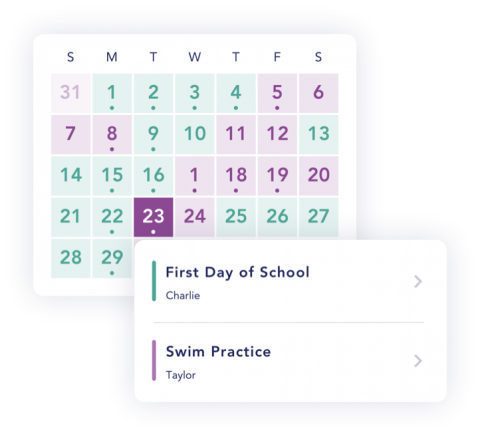
Easiest Way to Manage 2-2-3 Custody Schedules
OurFamilyWizard knows that co-parenting is challenging to manage alone. That’s why they created thoughtfully designed calendars for parents to manage and track parenting schedules, like a 2-2-3 routine
Much more powerful than a traditional calendar, OurFamilyWizard’s Calendar for co-parents shows your parenting schedule and event details in a single, shared calendar. You can easily enter holidays, birthdays, events, and vacations. Plus, you can send your co-parent requests for one-time changes to your regular parenting schedule using the schedule change request feature.
As a guardian ad litem, I believe OurFamilyWizard offers the best, most straightforward way to create, manage, and track parenting schedules These tools help to free up your time and energy, allowing you to focus on your kids instead of your schedule.
OurFamilyWizard gives you more than just a calendar. The app offers other features to support co-parenting, like messaging, expense and payment tracking, file sharing, and more.
A Note on Terminology
In general, the term “physical custody” refers to which parent a child lives with. Today, many experts use other terms to describe this arrangement, like “parenting schedule” or “parenting time arrangement.” These new terms better represent a relationship and the parent’s responsibilities for their children. But just a heads up: this article uses these older and newer terms interchangeably.

